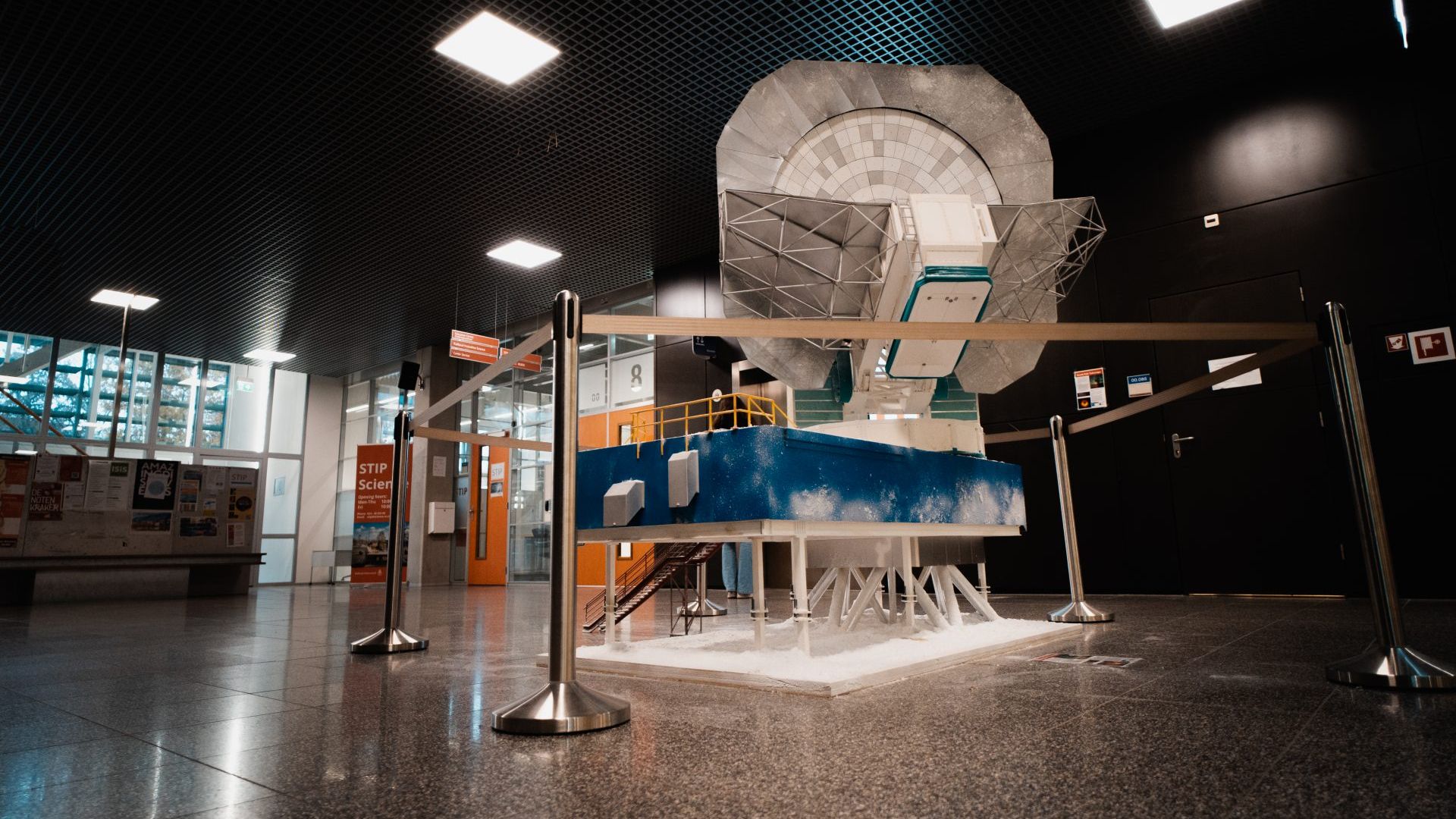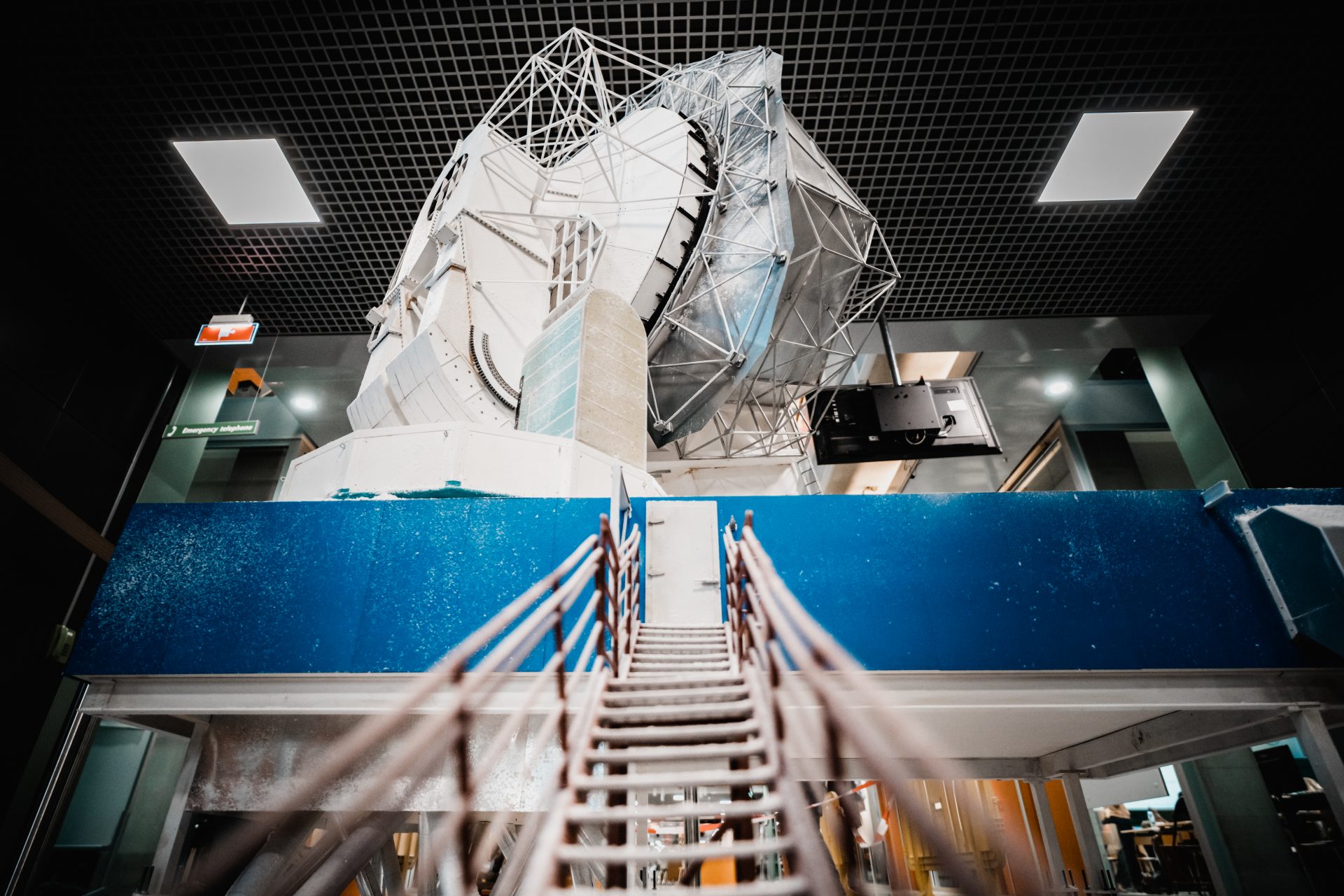Scale model exhibit of giant telescope in Huygens building
-
 De manquette van de South Pole Telescope in het Huygensgebouw. Foto: Johannes Fiebig
De manquette van de South Pole Telescope in het Huygensgebouw. Foto: Johannes Fiebig
For the next two months, the Huygens building will be housing a scale model of the South Pole Telescope, one of the telescopes used by astronomers to take pictures of black holes. The exhibit is motivated by a visit of the NWO committee, which will evaluate a grant application for a new telescope on a mountain in Namibia.
The two artists are watching nervously as their work is unloaded from the truck behind the Huygens building. Iede Reckman and Bas de Boer have built a scale model of the South Pole Telescope, one of the instruments in the worldwide network of telescopes that led to in 2019. The model has been on display at the Faculty of Science building since last week and will be there for the next two months.
The plan to exhibit the model has been set for some time, according to Amanda Schut, project manager of the Astronomy department. ‘The Event Horizon Telescope project is very important research for the university.’ On top of that there was a specific motivation: a committee for the NWO (Dutch organisation for Scientific Research) visited the Huygens building to evaluate a grant proposal. ‘We wanted to give them an idea of what a radio telescope looks like.’
Piece of the puzzle
The potential grant is intended for another telescope, the African Millimetre Telescope (AMT), The AMT is the missing piece of the puzzle that is the network of the Event Horizon Telescope, according to Schut. ‘These telescopes are spread out across the world, but there is a significant gap in the southern hemisphere. A telescope in Namibia is essential for higher quality imaging.’
The university already has financing in place for the research project in Namibia, but the funds for getting the telescope on the mountain are still lacking. The installation is currently in Chile, Schut explains. ‘The telescope will be disassembled, brought to France to receive an upgrade, and then it will be shipped to Namibia; that undertaking requires funding. Once that’s done, the project can get off the ground.’
Glue
The AMT researchers will hear the results of their grant application in mid-January. In the meantime, the model in the Huygens building gave the NWO committee a good impression of a radio telescope. The two artists and a production team of film studio Mirage3D have replicated the South Pole Telescope in minute detail.
‘It was an incredible challenge to recreate the telescope realistically and to scale’, according to Reckman. He and De Boer studied the original telescope extensively. ‘Google Streetview allows you to look at the South Pole. And we looked at a lot of photographs to get the details right, like those bolts and how many there are to a panel. Those details make it realistic.’
The model was not constructed with moving in mind. It was originally designed for a documentary on black holes produced by Mirage3D, the European Southern Observatory and Radboud University. The model is quite big (roughly 3 meters on each side), hard to lift and vulnerable. De Boer: ‘we put all those little bits on one at a time.’
However, at the service entrance it turned out that getting the model safely into the building would be no mean feat: there was no way to fit the telescope between the rods of the industrial lift. ‘We measured all the doors beforehand, but we forgot the elevator’, Schut says. And so, there was nothing for it but to load the installation back onto the truck.
After a quick sidebar, they managed to get the model in place via a side entrance with wide doors, but not without some damage: the paint of the shield surrounding the telescope flaked off. De Boer suspects that that is due to temperature differences in storage – the model spent the past year in a container. Some glue should suffice to take care of the issue. ‘Fortunately, it’s not a lot of damage. We’ll fix it.’
Inflatable planetarium
The South Pole Telescope model was not the only attraction at the beta faculty last week. One of the hallways of the Huygens building also housed an inflatable planetarium. It was used by Lott Ndeyanale, the first Namibian PhD student of the AMT project, to give the NOW committee a tour of the galaxy.
It was intended to demonstrate the astrophysics lectures that AMT researchers plan to host in Namibia over the coming years. A similar planetarium will be touring primary- and secondary schools throughout the country. ‘We want to support the development of knowledge in Namibia’, as stated by Amanda Schut. ‘One of the things that’s really helpful for children is to be able to look at the starry sky and fly to any place they want to know about.’
Translated by Jasper Pesch.




